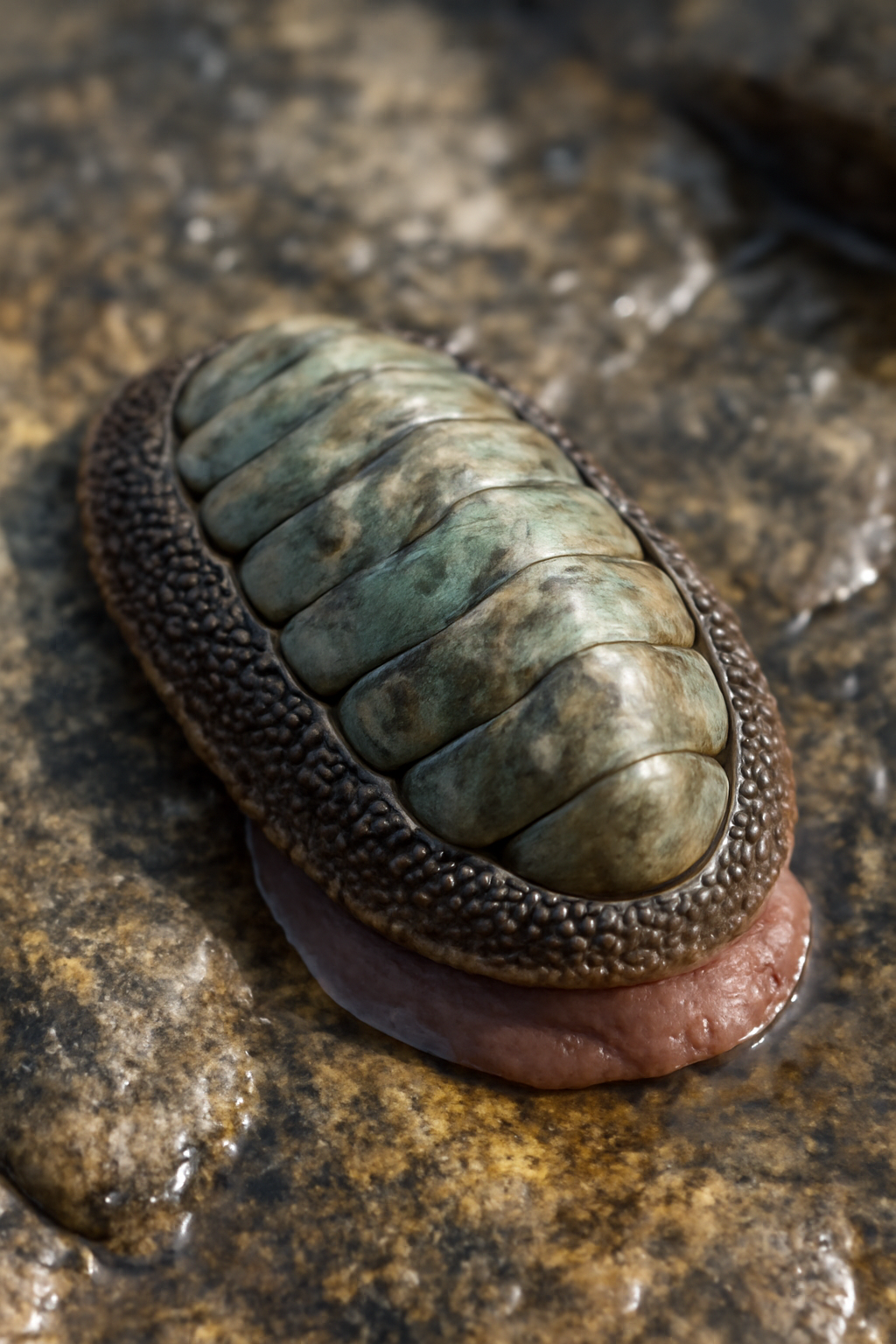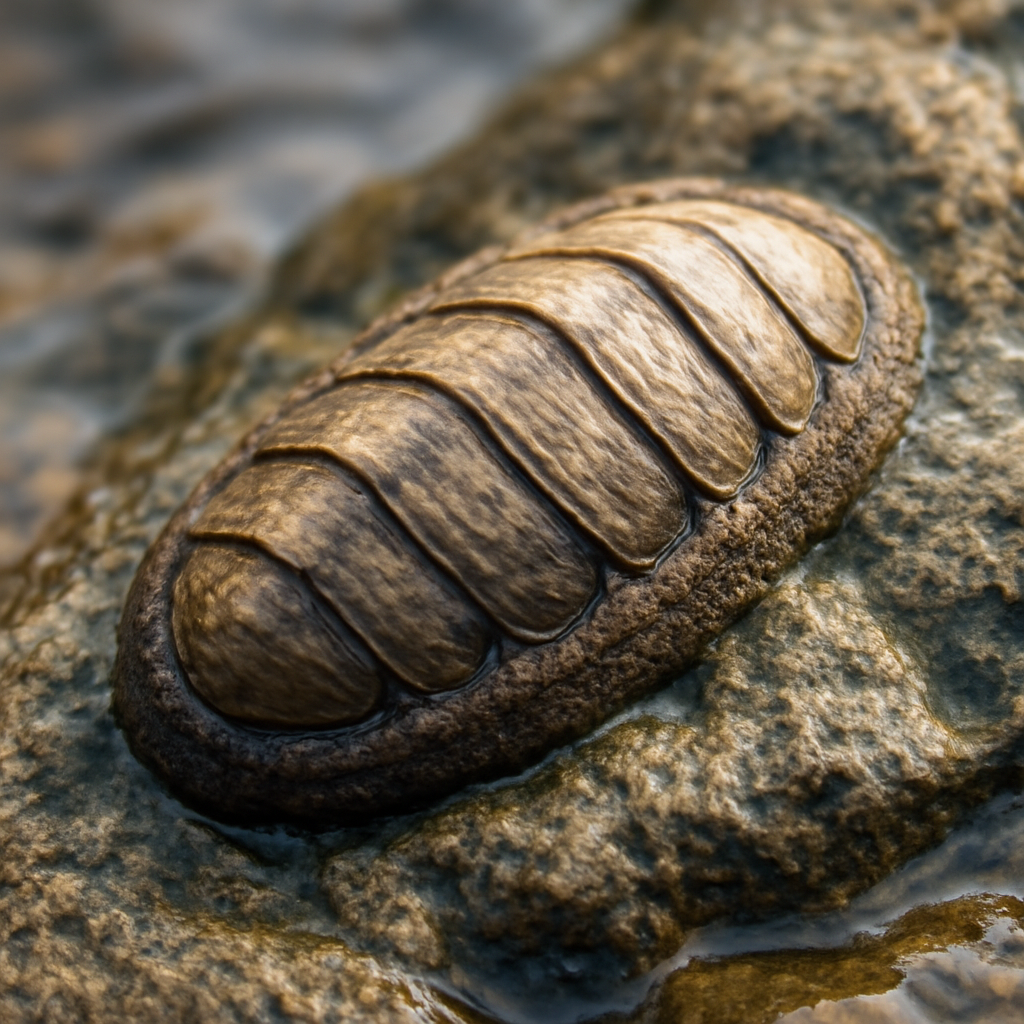Introduction
Chitons are marine mollusks classified under the class Polyplacophora, sometimes called sea cradles or coat-of-mail shells due to their distinctive armored, segmented dorsal plates. They are notable for their flat, oval bodies covered with eight overlapping calcareous plates embedded in a girdle. They are found worldwide, predominantly in intertidal and subtidal zones on hard substrates such as rocky shores. The genera include many species exhibiting varied morphological adaptations and ecological roles in marine habitats. Their ability to cling tenaciously to rocks and scrape algae with a specialized radula makes them important grazers in biofilm and algal communities.
Classification of Chiton or Ischnochiton
| Taxonomic Rank | Name | Characteristics |
|---|---|---|
| Kingdom | Animalia | Multicellular, eukaryotic organisms |
| Phylum | Mollusca | Soft-bodied invertebrates with muscular foot |
| Class | Polyplacophora | Marine mollusks with eight dorsal plates |
| Order | Chitonida | With well-developed girdle and eight plates |
| Family | Chitonidae / Ischnochitonidae | Families including robust chitons and related forms |
| Genus | Chiton / Ischnochiton | Polyplacophorans with distinct plate and girdle morphology |

Habit and Habitat
Chiton and Ischnochiton typically inhabit hard substrates in marine intertidal and subtidal zones, where wave action and tides expose them to variable conditions. They cling strongly to rocks, avoiding predation and desiccation. While most species are found in shallow waters, some inhabit deeper marine zones. They prefer surfaces covered with microalgae, bryozoans, or encrusting organisms, which serve as their food sources.
The tenacity of chitons is particularly important on rocky shores exposed to waves, allowing them to resist dislodgement. Some species seek crevices or under boulders for protection during low tide. Their slow movement across the substrate is used to graze on biofilms using their radula, a chitinous, rasp-like feeding structure.
Geographical Distribution
Chitons are cosmopolitan, found in temperate, tropical, and polar oceans worldwide. The genus is represented largely in colder and temperate waters, while Ischnochiton species often occupy tropical to warm temperate regions. Their adaptability to different substrate types and wave exposures allows wide distribution along rocky coasts globally.

General Characteristics
- Commonly called as sea mouse, measuring about 1 to 5 cms.
- Body is elliptical, bilaterally symmetrical and dorsoventrally flattened and is differentiated into a small, indistinct head, a large flat foot and a dorsal mantle forming a roof-like covering.
- Head contains ventral mouth and labial palps. Below head is sole of foot ventrally.
- Eyes and tentacles are absent. Mouth and anus are opposite ends. Dorsal side of mantle contains a linear series of 8-calcareous overlapping plates marked with lines of growth. Sides of mantle form mantle girdle.
- Several pairs of bipectinate ctenidia are found in a complete rows on either side of the body and lie in a mantle groove between foot and ventral side. Plates are surrounded and kept in place by a muscular integumental fold called girdle.
- Entire periphery of the mantle girdle contain small calcified tubercle or spicule.
- Exposed part of the plate is called as tegumentum and overlapping part is called as articulum.
- Body Form: Oval, bilaterally symmetrical, dorsoventrally flattened.
- Shell: Composed of eight articulating dorsal plates or valves embedded in a leathery, muscular girdle.
- Girdle: Surrounds the plates, often ornamented with scales, spines, or bristles.
- Size: Typically ranges from 2 to 10 cm, though some species like Cryptochiton stelleri can reach 43 cm.
- Foot: Large, flat muscular organ extending under the body for locomotion and adherence.
- Radula: Specialized feeding organ with rows of teeth used to scrape algae and to feed on encrusting organisms.
- Sensory Organs: Includes small eyes and aesthetes on shell plates allowing light detection.
- Respiration: Gills located in pallial grooves on either side of the foot.
- Coloration: Varies widely, often camouflaged with surroundings, sometimes bright or iridescent.
Special Features
- Articulating Plates: Allow flexibility for movement and curling into a ball for protection.
- Girdle Ornamentation: Enhances protection and camouflage against predators.
- Radula Strength: Contains magnetite-hardened teeth, making it the strongest biomineralized structure known.
- Sensory Aesthetes: Tiny organs in the shell plates provide visual and chemical information aiding in navigation and predator avoidance.
- Locomotion Mechanism: Muscular foot combined with valve flexibility enables the chiton to cling to uneven surfaces and to move slowly.
- Protective Curling: When dislodged, chitons curl into a tight ball protecting soft ventral parts.
Identification
Identification is based on:
- Shell plate sculpture and arrangement.
- Girdle characteristics (presence of scales, bristles, spines).
- Radula tooth structure.
- Color patterns and size.
- Anatomical examination of mouthparts and girdle features.
- Molecular approaches are increasingly used to corroborate morphological identification.

Life Cycle and Reproduction
They have separate sexes but some species are hermaphroditic. Fertilization is typically external; gametes are released into the water column. Larvae hatch into trochophore larvae that eventually metamorphose into juvenile chitons, settling on substrate and growing to adults.
Reproduction can be seasonal and heavily influenced by environmental factors such as temperature and food availability. Some species brood eggs, while others release planktonic larvae that contribute to marine plankton ecosystems.
Ecological Role and Importance
- Grazers: Primarily herbivorous, controlling algal growth on rocks and contributing to biofilm regulation.
- Ecosystem Engineers: Their grazing influences community structure and succession of intertidal organisms.
- Prey: A key food source for fish, sea stars, crabs, and birds.
- Indicator Species: Sensitive to pollution and environmental changes, serving as bioindicators.
- Research Models: Their unique radula and protective shells have been studied for biomaterial science.
References
- https://en.wikipedia.org/wiki/
- https://www.britannica.com/animal/-mollusk
- https://www.vedantu.com/animal/
- https://vajiramandravi.com/current-affairs/chitons/
- https://animalfact.com/
- https://ucmp.berkeley.edu/taxa/inverts/mollusca/polyplacophora.php
- https://www.discoverwildlife.com/animal-facts/insects-invertebrates/-guide-habitat-dietl
- https://www.museum.qld.gov.au/learn-and-discover/animals-of-queensland/molluscs/chitons
- https://www.swtecologyservices.org/wildlife-explorer/marine/sea-snails-and-sea-slugs/chitons
- https://zookeys.pensoft.net/article/10476/
